| |||||||
| Search Forums |
| Advanced Search |
| Go to Page... |
 |
| Search this Thread |  73,931 views |
| | #1 |
| Senior - BHPian Join Date: Nov 2011 Location: Chennai
Posts: 1,803
Thanked: 6,579 Times
| Are Indian Hyundais different from developed market Hyundais? If so, how? Apart from CBUs and perhaps CKDs, every car manufactured and sold in India differs from the ones sold in developed markets in one way or many ways. It's a given that the feature list of Indian cars would be different from their counterparts sold in First World countries. Features that are of very little or no use in India (such as heated seats, heated steering wheel etc.) are deservedly given a miss, while those useful for Indian conditions (such as rear A/C vents, more powerful compressors etc.) are included in cars sold here. Unfortunately, this feature deletion also extends to safety features. While almost every car sold in developed countries gets side & curtain airbags and even Electronic Stability Program as standard, these are usually available only on the top-spec variants of mainstream cars in India, if at all, as many manufacturers don't even bother to provide these crucial active & passive safety features. What's more, while things like Autonomous Emergency Braking (including pedestrian & cyclist detection systems) have become commonplace in even economy cars in the First World, they remain restricted to premium & luxury cars in India (for now). Then, we have unique conditions in India. The ground clearance of cars sold in India is usually a few centimetres more than the GC of their developed market counterparts. We also have the unique 4 metre limit for cars, to be eligible for a lower tax slab. This has resulted in quite a few cars having their bumpers and other parts reduced in length in order for the car to measure less than 4 metres. Apart from all this, the quality of parts used for the Indian market may differ from those used for developed markets, even if those developed market cars are manufactured and exported from here. Also, one manufacturer in particular is notorious for its extremely unhealthy obsession with lowering the weight of its cars sold in India by any means possible (in order to increase their fuel efficiency). This has resulted in some very unpleasant epithets being given to its light weight cars sold in India. The quality of parts may also extend to the quality (and therefore, strength) of metal used for building the car, both external sheet metal (which gives a feel of the build quality - "solid" or "tinny" or something inbetween) and the metal used for structural members (which plays a role in torsional stiffness of the chassis as well as crash safety). The number and quality of welds may also vary. It is quite difficult to find out if the characteristics mentioned in the previous paragraph vary between the cars sold in India and those sold in First World markets. Of course, it's relatively easy to find out if the sheet metal used on cars sold in India is of lower quality & thickness. But the other two, it's not easy at all! In this thread, we shall deal with Hyundais sold in India and compare them with Hyundais sold in the developed First World markets. To be specific, I shall reveal the chassis diagrams that show the strength of steel used for chassis members, both of Indian Hyundais and the corresponding First World Hyundais, and compare them side by side. From the least expensive Hyundai car currently sold in India to the most expensive one, and everything inbetween, we shall take a look at each one separately in a separate post. All these diagrams are not mine. Of course not! They are the official ones Hyundai uses in their online service manuals for independent garages worldwide. Kudos to Hyundai for making such information available in the public domain!  Of course, public domain does not necessarily mean open and free-of-cost. Of course, public domain does not necessarily mean open and free-of-cost.The last time I posted such diagrams on this forum {here (Understanding car platforms, starting with the Hyundai Venue)}, it was to bust a pair of mighty myths created by shockingly clueless auto journalists and spread around by their equally clueless admirers about the platform the Hyundai Venue was built on. While it received mostly positive responses, a few were utterly shocked to see the mighty myths they so fervently believed in get smashed to smithereens. Sadly, they responded in a less-than-dignified manner (snide personal attacks, cheap comments and third rate trolling). My message to such folks is this. I openly challenge any person on this forum or anywhere else to disprove anything that I have shown or shall show in the future with adequate technical evidence. If I'm wrong, then go ahead and prove me wrong with technical evidence, instead of behaving in an undignified manner that doesn't belong in this forum or any decent place, for that matter. First up, we shall take a look at the most expensive Hyundai (by starting price) sold in India, the Kona EV. Indian Kona EV (OSi) and First World Kona EV (OS) - how different are they?I'll show you the monocoque of the two Konas from different angles. Observe carefully and see if there are any differences in the strength of metal used. Bottom view Indian Kona EV (OSi): 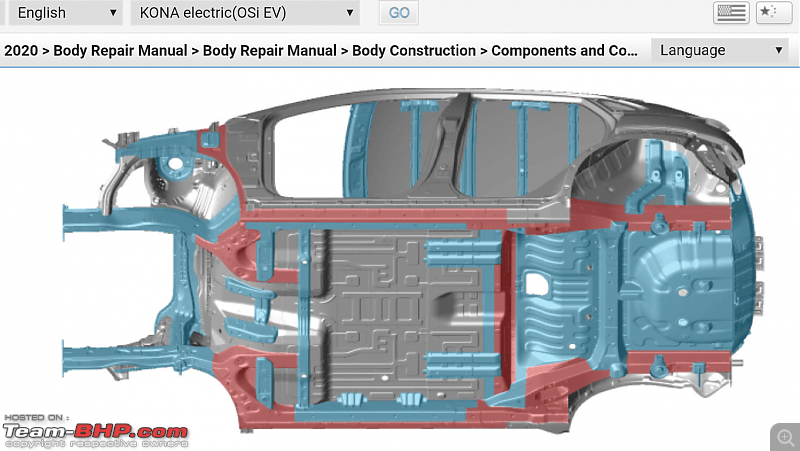 First World Kona EV (OS):  Top view from the front Indian Kona EV (OSi): 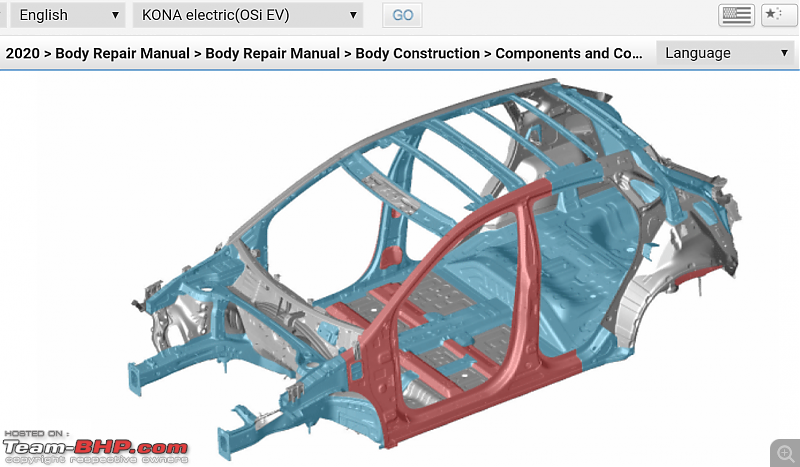 First World Kona EV (OS): 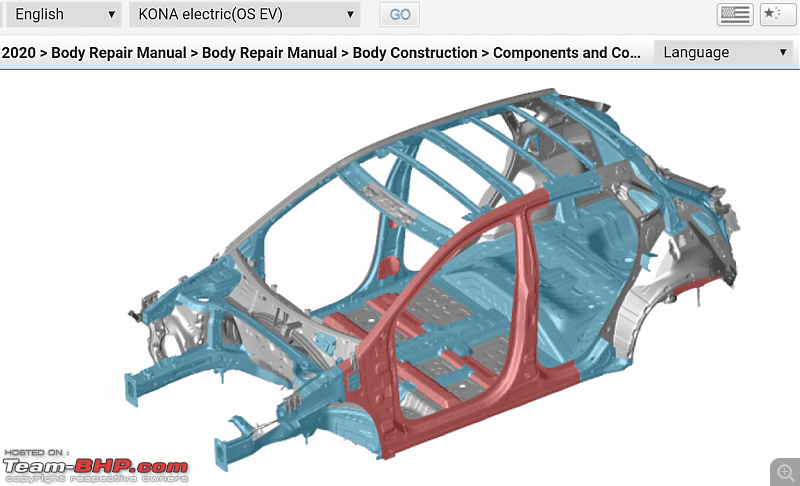 Top view from the rear Indian Kona EV (OSi):  First World Kona EV (OS):  Monocoque with external sheet metal Indian Kona EV (OSi):  First World Kona EV (OS):  Floor section housing the battery Indian Kona EV (OSi):  First World Kona EV (OS):  Legend: Grey denotes mild steel Blue denotes high strength steel Red denotes ultra-high strength steel Yellow (or greenish yellow) denotes aluminium alloy Are there differences in the strength of steel used for different members between the Indian Kona (OSi) and First World Kona (OS)? From the looks of it, no. They look exactly similar. Which is to be expected, as the Indian Kona (OSi) is not manufactured here, but assembled from CKD kits. At least as far as the strength of steel used is concerned, the Indian Kona (OSi) is the same as the one sold in developed markets (OS). Coming up in the next post: From the most expensive Hyundai currently sold in India to the least expensive one. We shall take a look at the Hyundai Santro.  Last edited by RSR : 14th November 2020 at 21:24. |
| |  (99)
Thanks (99)
Thanks
 |
| The following 99 BHPians Thank RSR for this useful post: | advenk999, Aish_4761, AkhilR, akshye, anandhsub, anb, Arnav Vaghela, Arun Venugopal, ashpalio, aveoman19, AYP, Bibendum90949, bongSENse, bpapache, brownkaiser, BZ25, CarNerd, carthick1000, CEF_Beasts, chiefpk, classiccurves, Contrapunto, cs_rajesh, dark.knight, dealer, DicKy, digitalnirvana, Doonite, Dr.AD, drrajasaravanan, findviru, fluidicjoy, Gaboonviper04, GipsyDanger, Godzilla, graaja, GTO, gupta_chd, hashcode, iamswift, icar, KA19Rao, Karthik Chandra, klgiridhar, landcruiser123, maddyoni10, MaheshBapurao, mh09ad5578, MinivanDriver, Mu009, murthy_p, nakul0888, NiInJa, nitrobahn, NPX, OSH, padmrajravi, padukulkarni9, PapaKiloSierra9, PetrolheadRup, ph03n!x, Pigcee, Poitive, PrasunBannerjee, R.G, RaghuVis, Rambo-RS, ramjiramu, RavenAvi, RBalaM, Researcher, RoadMonkey, ron82x3, roy_libran, sajaijayan, sakthivelm, samaspire, searacer932, Seenz, Sen, shancz, Shrayus_shirali, Shreyans_Jain, Simhi, SR7, srikanthmadhava, Stiggy_205, SuhairZain, The Rationalist, theexperthand, Tojo_GotBhp, Ultim8, v1p3r, varunswnt, vinya_jag, vredesbyrd, vsrivatsa, WhiteSierra, ysjoy |
| |
| | #2 |
| Distinguished - BHPian  Join Date: Nov 2013 Location: HR51/HR29/HR26
Posts: 2,751
Thanked: 21,223 Times
| Re: Are Indian Hyundais different from developed market Hyundais? If so, how? I won’t expect a CBU or CKD import to have any India specific structural changes. The likes of Kona and Tucson have no reason to be de-specced in any way. |
| |  (18)
Thanks (18)
Thanks
 |
| The following 18 BHPians Thank Shreyans_Jain for this useful post: | akshay81, aveoman19, digitalnirvana, giri1.8, Godzilla, GTO, klgiridhar, mh09ad5578, Napalm, one-77, OSH, RavenAvi, Seenz, The Rationalist, The_Outsider!, Turbanator, Turbohead, WhiteSierra |
| | #3 |
| BHPian Join Date: Apr 2016 Location: Pune
Posts: 454
Thanked: 1,555 Times
| Re: Are Indian Hyundais different from developed market Hyundais? If so, how? How are you sure that the 'i' in the model name always stands for India ? Is it mentioned in the online publication ? Last edited by Aditya : 15th November 2020 at 22:58. Reason: Removing opening paragraph - it's cool to use. Let's not give Hyundai ideas :) |
| |  (15)
Thanks (15)
Thanks
 |
| The following 15 BHPians Thank OSH for this useful post: | Cessna182, Deepsp, digitalnirvana, extreme_torque, greyhound82, janakiram_m, Karthik Chandra, RaghuVis, self_driven, sinharishi, The Great, The Rationalist, Turbohead, vishy76, WhiteSierra |
| | #4 | |
| Team-BHP Support  | Re: Are Indian Hyundais different from developed market Hyundais? If so, how? Quote:
The OEMs can be quite shameless; best way is to shame them via GNCAP + publicity (the kind that the Seltos + S-Presso + i10 Nios recently went through). It's pretty clear we can't leave everything to the government. | |
| |  (58)
Thanks (58)
Thanks
 |
| The following 58 BHPians Thank GTO for this useful post: | advenk999, akshay81, anandhsub, Bibendum90949, BZ25, CarNerd, catchjyoti, CEF_Beasts, chiefpk, chinchu.c, chinmaypillay, classiccurves, CoolFire, Deepsp, Dennis, Dr.AD, Gaboonviper04, GipsyDanger, Godzilla, jithin23, Keynote, Kingston, kkstile, klgiridhar, lemedico, mh09ad5578, Mu009, Mustang Sammy, nakul0888, Napalm, nihilanth, nikhilck, NTO, OSH, PapaKiloSierra9, PPS, PrasannaDhana, PrasunBannerjee, rajvardhanraje, RavenAvi, redohabitat, Researcher, RJ2285, Romeo_Mike, RSR, Scorpio80, Seenz, Shreyans_Jain, Simhi, SR7, sri_tesla, ssenhyd, SuhairZain, The Rationalist, theexperthand, turbowhistle, Utham123, WhiteSierra |
| | #5 | |
| Senior - BHPian Join Date: Nov 2011 Location: Chennai
Posts: 1,803
Thanked: 6,579 Times
| Re: Are Indian Hyundais different from developed market Hyundais? If so, how? Now, let's take a look at the monocoque of the least expensive Hyundai currently sold in India, the Santro. Indian Hyundai Santro (AH2)Bottom view:  Top view from the rear: 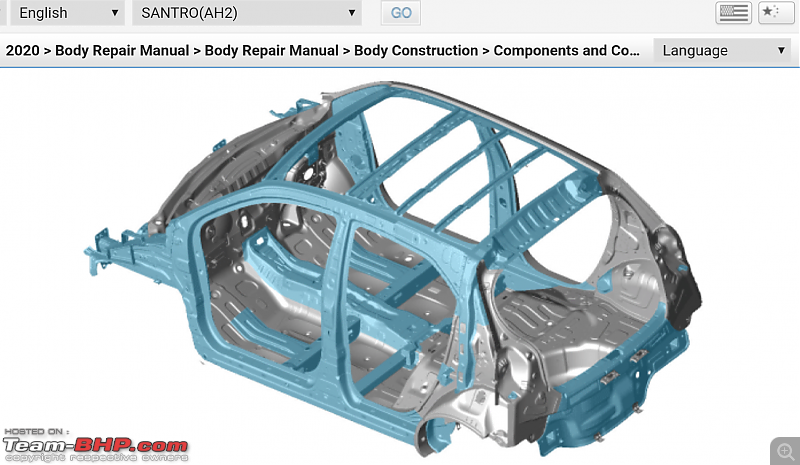 Top view from the front:  Legend: Grey denotes mild steel Blue denotes high-strength steel Do note that the top view from front doesn't show the roof cross members, while they're clearly shown in the top view from rear and bottom view. There are some minor but easily observable errors such as this one in a couple of the other diagrams as well (that will follow). The Indian Santro (AH2) hasn't been compared with a First World Santro because the latter does not exist. This generation of the Santro (AH2) began its life as an India-specific car, but is now also sold in some other developing markets of the world. The car isn't sold in any First World country, just like the car it replaced (i.e. Eon). The Santro is the same car in all the developing markets it is sold in, and there are no different versions of the car that can be compared side by side. Coming up in the next post: From an entry level ICE car to the most expensive ICE Hyundai currently sold in India. We shall take a look at the Hyundai Tucson.  --------------------- Quote:
It has been a convention for Hyundai to label their Indian cars with an "i" suffix in the codename. This has been the case since the very first Hyundai sold in India {i.e. the original, first generation Santro (MXi)}. This can also be found in some of the marketing materials and press releases issued by the company. Not only India, they also label some of their Brazilian cars with a "b" suffix and their Russian cars with an "r" suffix in their codenames. Such suffixes in the codenames are given only to those big car markets where Hyundai has a large presence and local manufacturing facilities. Thus the i, b, and r suffixes stand for India, Brazil and Russia (and not Indonesia, Bolivia and Rwanda, for instance). Last edited by RSR : 15th November 2020 at 14:33. | |
| |  (35)
Thanks (35)
Thanks
 |
| The following 35 BHPians Thank RSR for this useful post: | akshay380, anandhsub, anb, Arnav Vaghela, ashpalio, aveoman19, Carpainter, CEF_Beasts, chiefpk, dark.knight, Dr.AD, graaja, GTO, JithinR, Karthik Chandra, landcruiser123, mh09ad5578, Mu009, Napalm, PapaKiloSierra9, PetrolheadRup, ph03n!x, Ragavsr, Rambo-RS, ramjiramu, rav11stars, RavenAvi, Researcher, Seenz, shancz, srikanthmadhava, SuhairZain, The Rationalist, theexperthand, v1p3r |
| | #6 | ||
| BHPian Join Date: Apr 2016 Location: Pune
Posts: 454
Thanked: 1,555 Times
| Re: Are Indian Hyundais different from developed market Hyundais? If so, how? Quote:
Please don't think that I am defending Hyundai and targeting you. I just found this one ambiguous point and wanted to know more about it. I have no other interests in this thread or the other one. Quote:
According to you, the Kona which is sold here is the same as the international model structure wise. But still both of them have got different codenames; OSi and OS. This is when the Indian Kona is a CKD and not even made here. Now you have said that the Santro even though is an India specific model, it is also sold elsewhere. So then why doesn't the Indian Santro's codename carry the 'i' ? It is made in India and for India so the model we get here should have the 'i' and the one which is sold elsewhere should carry some other or no suffix. Now one may think that the 'i' is given only when a car is sold in the developed and developing markets together like with the Kona but because the Santro is sold only in the developing markets; here and elsewhere, the 'i' has been given a miss but then that is also a big assumption in itself. Even to consider that the Santro sold here is the exact same in other developing markets is an assumption unless there is documentation to prove the same. | ||
| |  (9)
Thanks (9)
Thanks
 |
| The following 9 BHPians Thank OSH for this useful post: | digitalnirvana, Godzilla, greyhound82, GTO, mh09ad5578, RavenAvi, Researcher, self_driven, SuhairZain |
| | #7 | |
| BHPian Join Date: Sep 2020 Location: Bangalore
Posts: 98
Thanked: 568 Times
Infractions: 0/1 (10) | Re: Are Indian Hyundais different from developed market Hyundais? If so, how? Quote:
This is why modern EVs of skateboard design/architecture( like Tesla) with batteries in the floor are inherently safer than IC engine vehicles. They have larger crumple zone in the front since there is no huge 300-500 Kg block of steel called engine. The electric motor is very compact and mostly near the axles. A car which is very heavy & has high-strength steel in the wrong places can actually be more dangerous if it does not have adequate crumple zones on all sides of the exterior of the car. That’s why I believe that weight of the car, although an important indication, is not always or the only way to know it’s crash protection. For example a heavy hood that crumples will help in case of a crash, but if the doors panels are extremely hard and don’t crumple to a certain extent, then it will hit the passengers badly. For ex Last edited by Sheel : 15th November 2020 at 18:18. Reason: Please quote only relevant bits of a post. Thanks. | |
| |  (8)
Thanks (8)
Thanks
 |
| The following 8 BHPians Thank Napalm for this useful post: | digitalnirvana, Dr.AD, Gaboonviper04, GTO, RavenAvi, self_driven, sri_tesla, SuhairZain |
| | #8 |
| Senior - BHPian Join Date: Oct 2014 Location: Mangalore
Posts: 1,226
Thanked: 3,244 Times
| Re: Are Indian Hyundais different from developed market Hyundais? If so, how? May not be so structurally but assuming the Creta sold in Middle east and South American markets is exported from here then feature wise we are missing out a bit of features. For example those countries get adjustable rear headrests from base model itself. What's more? There's 3 adjustable headrests at the back like the Seltos but Hyundai India doesn't offer more than 2 in the Creta even in top variant. |
| |  ()
Thanks ()
Thanks
 |
| | #9 |
| Senior - BHPian Join Date: Nov 2011 Location: Chennai
Posts: 1,803
Thanked: 6,579 Times
| Re: Are Indian Hyundais different from developed market Hyundais? If so, how? Indian Tucson (TLi) and developed market Tucson (TL) - how different are they?Let's take a look at the Indian Tucson and compare it with a First World Tucson. Top view Indian Tucson (TLi):  First World Tucson (TL): 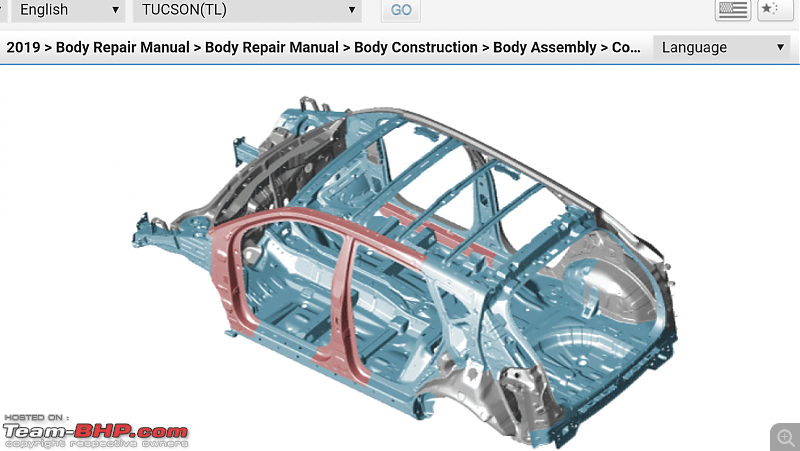 Bottom view Indian Tucson (TLi):  First World Tucson (TL):  Legend: Grey denotes mild steel Blue denotes high-strength steel Red denotes ultra high-strength steel Do note that the TLi's chassis diagrams are for the 2020 model, while the TL's chassis diagrams are for the 2019 model. This is because the next generation Tucson (NX4) has just recently gone on sale in a few First World markets as the 2020 model. India will get the next generation Tucson some time later. As one can observe from the diagrams, there seems to be no noticeable difference between the two Tucsons. So, as far as the strength of steel is concerned, an Indian Tucson (TLi) is the same as a First World Tucson (TL). Coming up in the next post, a look at a Hyundai at the other end of the price spectrum.  Last edited by RSR : 16th November 2020 at 18:55. |
| |  (30)
Thanks (30)
Thanks
 |
| The following 30 BHPians Thank RSR for this useful post: | 2TR-FE, Aish_4761, akshay81, anandhsub, Arun Venugopal, aveoman19, CEF_Beasts, dark.knight, Gaboonviper04, giri1.8, GTO, Karthik Chandra, kkr2k2, landcruiser123, mh09ad5578, Mu009, nakul0888, PapaKiloSierra9, PetrolheadRup, ph03n!x, QuadraticAmoeba, ramjiramu, RavenAvi, Researcher, Seenz, shancz, sridhar-v, srikanthmadhava, SuhairZain, theexperthand |
| | #10 |
| Distinguished - BHPian  Join Date: Jun 2012 Location: BengaLuru
Posts: 5,658
Thanked: 19,398 Times
| Re: Are Indian Hyundais different from developed market Hyundais? If so, how? Looks to be an informative thread in the making. I would like to add one point if not already in the plan regarding these country specific adaptations. We find Maruti Suzuki doing this and lately Hyundai/Kia if we have to believe the differences in the crash tests as well as some earlier discussions. IMO, if the costs involved in doing the R&D for such a change like sheet metal thickness or some chassis components are lesser compared to the overall cost benefit achieved during production, that is what triggers the manufacturers to adopt this method. Consider this, for example, a premium car maker hardly sells 10k cars a year, and probably 1k cars of a certain type, and with sub variants. Now trying to make a change to a chassis member or so is a big deal at the R&D side and it will never justify the costs involved when there are usually that many number of prototype vehicles itself for a given model. When it comes to players like MS, Hyundai, India is a big market for them and the regulations here are not that stringent in comparison to Europe or USA. Due to this, they resort to making country specific changes and end up with such situations. In the longrun, they either develop entire platforms specific to such countries or if not make modifications to global platforms. No one will let go of extra profits or pricing advantages if they have a chance to do so. As long as they meet the minimum criteria which is currently the system in India, they will be internally compliant. On the other hand, consider Indian manufacturers who want to make a mark globally. For them, it will make no sense to work on a different chassis material or special reinforcement for something like the European market. Hence, they consider this aspect from day one of the design and creation of the platform and end up better prepared. Hence even if they have a small market share in a foreign country, they still dont have to break their heads over the homologation. The extra cost they will incur over the extra metal or reinforcement to chassis would not be a significant one. For the customer, this feels like a blessing in disguise. Similarly, if we take a look at the automotive scene in Pakistan, we are sure to get baffled. They still have the first gen Marutis on sale along with a few newer cars, but with barebone features like a Euro 2 engine, ABS, etc which are standard in our market. For a few cars which are CBU, they get an up to date kit since again, the lower volumes these cars sell will make the manufacturer really not customize it for the country. That is how the whole setup works for the manufacturer. |
| |  (13)
Thanks (13)
Thanks
 |
| The following 13 BHPians Thank audioholic for this useful post: | 2TR-FE, anandhsub, DicKy, Gaboonviper04, GTO, JithinR, Night_Fury, ph03n!x, Rambo-RS, RavenAvi, Seenz, srikanthmadhava, SuhairZain |
| | #11 | |
| Senior - BHPian Join Date: Nov 2011 Location: Chennai
Posts: 1,803
Thanked: 6,579 Times
| Re: Are Indian Hyundais different from developed market Hyundais? If so, how? Quote:
The "i" suffixes are indeed given to many (not all) Indian models. I took some VINs of cars posted by members in the VIN decoding thread and got their details. All of them have an "i" suffix as they are sold in India. These are the VINs I used - those of a Venue, Creta and Tucson: Indian Venue (QXi):  Indian Creta (SU2i):  Indian Tucson (TLi):  Of course, exceptions to the "i" suffix convention do exist for certain Indian models such as the Santro (AH2), Grand i10/Xcent (BA) and Grand i10 Nios/Aura (AI3). Also, the previous generation Indian i20 (IB) has a different codename compared to the equivalent European i20 (GB), and the new Indian i20 (BI3) has a different one compared to the new European i20 (BC3). Last edited by RSR : 16th November 2020 at 23:59. | |
| |  (15)
Thanks (15)
Thanks
 |
| The following 15 BHPians Thank RSR for this useful post: | anb, dark.knight, GTO, Karthik Chandra, klgiridhar, landcruiser123, Mtv, OSH, ph03n!x, RavenAvi, samaspire, Seenz, shancz, srikanthmadhava, SuhairZain |
| |
| | #12 |
| Senior - BHPian Join Date: Jun 2015 Location: Chicagoland
Posts: 2,985
Thanked: 6,858 Times
| Re: Are Indian Hyundais different from developed market Hyundais? If so, how? From what I understand in this thread, the Tucson sold in India and abroad should have comparable chassis strength. @RSR: I'm extremely curious to see whether this is a trend. For example: Back in 2015-16, I had a conversation with my local FNG kept manager who insisted that Hyundai's quality was going down. His observation was that part quality & construction was declining. According to him, it was much better in the Getz > i20 (1st gen) > Elite i20 (not 2020 one). Also, Hyundai stopped exporting the Elite i20 to Australia and initially deleted 6 airbags, rear disc brakes, etc from the Indian version. This might suggest a trend in making cheaper India-specific models with many compromises. I know it may be asking for too much and irrelevant, but is there any chance you can get the same data for the Getz, i20 (2008-2014), and Elite i20 (2014-2020)? Thanks  Last edited by landcruiser123 : 17th November 2020 at 09:38. |
| |  (3)
Thanks (3)
Thanks
 |
| The following 3 BHPians Thank landcruiser123 for this useful post: | digitalnirvana, Godzilla, Seenz |
| | #13 | |
| BHPian Join Date: Aug 2019 Location: Bahrain
Posts: 935
Thanked: 4,974 Times
| Re: Are Indian Hyundais different from developed market Hyundais? If so, how? Quote:
| |
| |  (2)
Thanks (2)
Thanks
 |
| The following 2 BHPians Thank dragracer567 for this useful post: | neil.jericho, SNGHPRKSH |
| | #14 | ||||||
| BANNED Join Date: Oct 2011 Location: Hyderabad
Posts: 12,350
Thanked: 21,411 Times
| Re: Are Indian Hyundais different from developed market Hyundais? If so, how? Quote:
Hyundai GetzQuote:
Hyundai i20Quote:
Hyundai i20Quote:
Hyundai Elite i20Quote:
Hyundai Elite i20Quote:
| ||||||
| |  (3)
Thanks (3)
Thanks
 |
| The following 3 BHPians Thank a4anurag for this useful post: | anb, landcruiser123, Seenz |
| | #15 | |
| BHPian Join Date: Feb 2020 Location: Bangalore
Posts: 161
Thanked: 842 Times
| Re: Are Indian Hyundais different from developed market Hyundais? If so, how? Thank you RSR for this analysis. It gives us an inside look into the kind of changes / cost-cutting that manufacturers do for our Indian market. I am eager to see the results for all the Hyundai cars. I believe we can extend some of the analysis to the Kia cars as well. Quote:
 . Initially, I had planned to buy a Seltos and one factor was the good safety rating (I think for their Australian model). Now that the actual crash test results are out, I thank my wife for making me buy the more expensive but much safer Tuscon. . Initially, I had planned to buy a Seltos and one factor was the good safety rating (I think for their Australian model). Now that the actual crash test results are out, I thank my wife for making me buy the more expensive but much safer Tuscon. | |
| |  (6)
Thanks (6)
Thanks
 |
| The following 6 BHPians Thank QuadraticAmoeba for this useful post: | dark.knight, Dharmen, giri1.8, klgiridhar, landcruiser123, Seenz |
 |


